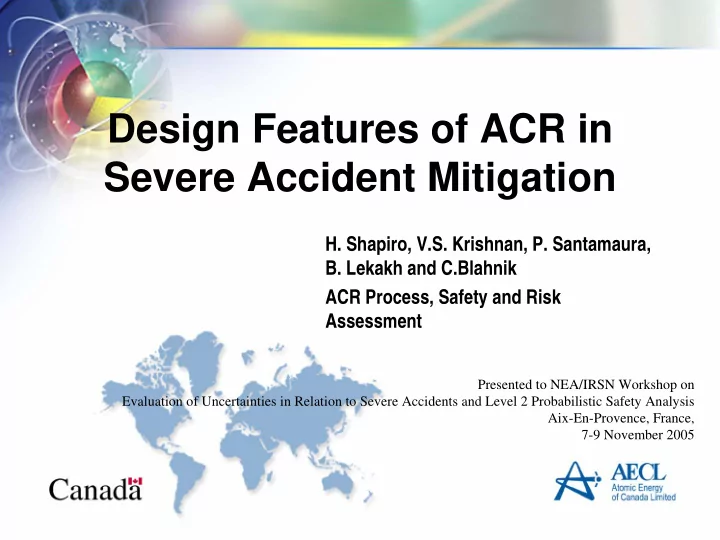

Design Features of ACR in Severe Accident Mitigation H. Shapiro, V.S. Krishnan, P. Santamaura, B. Lekakh and C.Blahnik ACR Process, Safety and Risk Assessment Presented to NEA/IRSN Workshop on Evaluation of Uncertainties in Relation to Severe Accidents and Level 2 Probabilistic Safety Analysis Aix-En-Provence, France, 7-9 November 2005
Presentation Outline • Severe Accident Management (SAM) • ACR Design • ACR SAM-related design features • Conclusions Pg 2
Severe Accident Management (SAM) • Actions to: − Prevent core damage, terminate progress of core damage and retain core within vessel − Maintain containment integrity − Minimize offsite releases • ACR core damage characteristics different from pressure vessel reactors Pg 3
ACR Design Overview ACR • Horizontal fuel channels surrounded by heavy water moderator • Slightly enriched uranium fuel and light water reactor coolant • Two fast acting, fully capable, diverse and separate shutdown systems physically and functionally independent • Emergency Core Cooling consists of emergency coolant injection (ECI) system and long term cooling system (LTC) Pg 4
ACR Design Overview ACR • Reserve Water System − emergency source of water by gravity to the steam generators, moderator RESERVE WATER TANK system, shield cooling and heat SPRAY HEADERS transport system • Secondary control area FEEDWATER EMERGENCY FEEDWATER EMERGENCY − monitoring and control capability to SG SG shutdown reactor and maintain the HTS MAKE-UP HTS MAKE-UP plant in a safe shutdown state following CALANDRIA VAULT MAKE-UP MODERATOR MAKE-UP events that render the main control room unavailable ROH RIH RIH ROH • Electrical power systems supply − safety-related portions are seismically LTC GRADE LTC GRADE REACTOR LEVEL TANK LEVEL TANK qualified and consist of redundant SUMP SUMP divisions of standby generators, batteries, and distribution to the safety- related loads. TO LTC TO LTC ONLY ONE LOOP OF HTS IS SHOWN Pg 5
ACR Design Overview • Containment system: strong structure, (steel lined and low leakage) with isolation, hydrogen control and heat removal Pg 6
ACR Core Damage States • Limited Core Damage (CANDU-specific) • In-Calandria Core Damage (analogous to In-Vessel Core Damage in ALWRs) • Ex-Calandria Core Damage (generic to all designs) Pg 7
Prevention of Core Damage • Conventional AM provisions − Keep inside of pressure tubes flooded with liquid water to prevent fuel and pressure deformations • HTS depressurization (Engineered and Inherent features) − Two independent, reliable, engineered systems to depressurize HTS to below ECIS injection pressure using MSSVs − Inherent “thermal fuse” (pressure tube failure) allows flooding of fuel by passive water supplies from ECIS or RWS • SAMDA − Engineered emergency cross-connections of safety grade systems Pg 8
Core Retention Design Provisions • 2 vessels to retain hot core − Fuel channels − Calandria Pg 9
Retention in Fuel Channels NOMINAL H 2 O coolant calandria tube • Fuel channels depressurized pressure tube fuel element before fuel heats up annulus gap D 2 O moderator • Heat rejection paths established SAGGED with DEFORMED FUEL BALLOONED with DEFORMED FUEL by fuel and pressure tube deformations while the fuel is still solid • Channels submerged in liquid SAGGED with SLUMPED FUEL BALLOONED with SLUMPED FUEL water ensures retention of hot, solid fuel debris within the fuel channels. approximately to scale Pg 10
SAM Design Provisions SUSPENDED • 2 steam relief paths DEBRIS properties & mobility • Water make-up by gravity from RWS • Level measurement in calandria and RWS tank GAS FLOW • Means to control calandria water PATTERNS & DEBRIS-WATER HYDROGEN INTERACTIONS make-up BROKEN CHANNEL dissassembly • Cross sections for alternate services CHANNEL FAILURE • SAMDA – calandria vessel design optimization to reject heat to shield water TERMINAL DEBRIS properties & coolability Pg 11
Retention in Calandria Vessel • Strong calandria vessel • Outer walls in contact with water • Passive heat sink provided by RWS Pg 12
Core Damage Termination • Termination by flooding core materials with water and keeping them flooded thereafter. • Design provisions for termination in: − Fuel channels (LTC from sumps; RWS water by gravity) − Calandria vessel (RWS water by gravity) − Calandria vault (ACR layout meets EPRI core debris spreading criterion) • SAMDA − Recirculate sump water through RWS tank Pg 13
Containment Integrity Maintenance Challenges: • Pressurization • Flammable gas control • Core concrete interaction Pg 14
Prevention of Containment Pressurization • Design features: − Strong containment − Containment sprays − Local Air Coolers to condense steam (SG vault, RB dome, moderator room and other locations) − Post-accident heat sinks for HTS, calandria vessel, and shield water to stop steaming into containment • SAMDA − Containment venting Pg 15
Prevention of Containment Pressurization Sprays RWT (2500 m 3 Total) 1000 m 3 SPRAY SPRAY HEADERS HEADERS LTC GRADE LTC GRADE REACTOR LEVEL TANK LEVEL TANK SUMP SUMP LTC SYSTEM TO RIH (ECC) FROM ROH FROM ROH TO RIH (SDC) (SDC) (SDC) LTC SYSTEM Pg 16
Prevention of Containment Pressurization Local Air Coolers DOME RWT RWT LACS SG VAULT ENCLOSURES COOLING COOLING COILS COILS SG VAULT SG VAULT LACS LACS FANS FANS REACTOR Pg 17
Offsite Release Minimization • Isolated ACR containment is leak tight (less than 0.2% per day at design pressure) • Containment structure has a large margin (more than twice the design pressure) • Fail safe design • SAMDA − Containment venting Pg 18
Flammable Gas Control • Post-accident hydrogen control strategy − Remove hydrogen from containment atmosphere − Prevent hydrogen detonation • Design provision − Passive autocatalytic recombiners and igniters − Containment structure designed to provide forced and natural circulation mixing Pg 19
Conclusions • Severe accident management design provisions ongoing from early stages of ACR design • Active heat sinks for process vessels capable of operating under severe accident conditions • Passive backup heat sinks will provide SAM more than 1 day to diagnose accident and establish ultimate heat sink • Robust containment design Pg 20
Pg 21
Recommend
More recommend